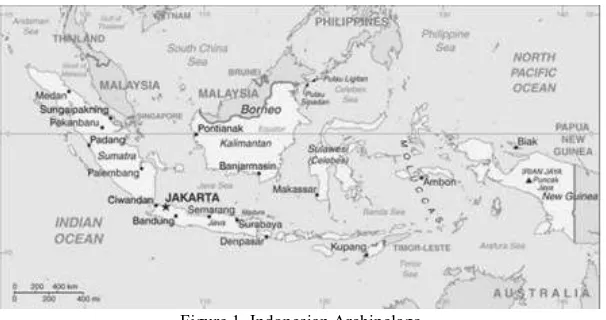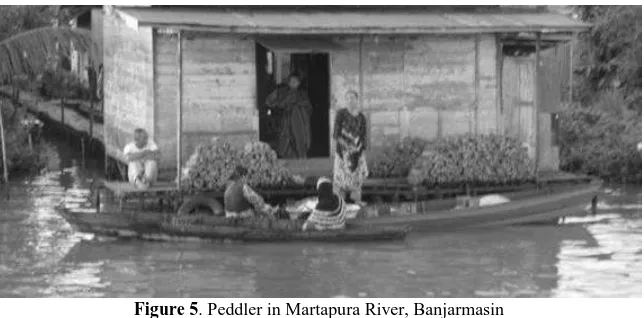EXPLORING COMMUNAL SPACE IN THE ARCHIPELAGO
Maria Immaculata Ririk Winandari1
1
Lecturer, Department of Architecture, Faculty of Civil Enginering and Planning, Trisakti University, INDONESIA, ririkwinandari@yahoo.com
ABSTRACT
Many Indonesian people live near the ocean or the river. Some of them even live on the water. Most of their individual activities as well as communal activities are carried out on the water. This paper describes the use of communal space by people who reside on the water. The communal life of people on the river and by the bay in Banjarmasin and Pohuwatu will be portrayed to illustrate the living culture on the water. The goal is to provide the understanding of living culture that can be used as a reference to create a better living for people that live on the water.
Keyword: communal space, living on the water, Banjarmasin, Pohuwato.
ABSTRAK
Sebagian besar penduduk Indonesia tinggal berdampingan dengan laut atau sungai. Beberapa di antara mereka bahkan bermukim di atas air. Sebagian kegiatan individual dan komunal penduduk tersebut berlangsung di air. Kehidupan komunal penduduk di atas air digambarkan melalui budaya menghuni masyarakat yang tinggal di sungai di Banjarmasin dan di laut di Pohuwato. Makalah ini bertujuan untuk memberikan pemahaman mengenai budaya menghuni masyarakat yang tinggal di atas air sehingga dapat digunakan sebagai acuan agar kehidupan masyarakat tersebut dapat menjadi lebih baik.
Kata kunci: ruang komunal, kehidupan di atas air, Banjarmasin, Pohuwato.
1.
INTRODUCTION
Indonesia is the largest archipelago in the world which consists of 17.508 islands with approximately 81% area consists of the sea [1]. Land area that only 19% of the country traversed by 5,590 rivers [2]. Indonesian statistics mention that Indonesian population was 237,641,326 people in 2010 (Statistics Indonesia, 2016). According to the CIA (2016), estimation of Indonesian population in 2016 approximately 258,316,051 people (the high 5 in the world). As seen from the land area percentage and the number of river as well as the population of Indonesia, it is conceivable that some Indonesian communities living alongside the river or the sea. In fact, some of them even live on the river as well as on the sea. Two of them are Bajo tribes and Banjar tribes. Both communities for long time ago are living on the water. Referring our previous study (Winandari, 2009: 6), some housing was built illegally at the river flood plain, estuary side, and the beach. Regulatory settlement in Indonesia put aside living culture on the water. Settlement on the water both in the river and by the sea are considered illegal even though they have lived in that area long before the regulation made and enforced.
Figure 1. Indonesian Archipelago
Living culture on the water can be seen through the use of communal space. These spaces play an important role in the local community as a place for socialization. Discussion about culture inhabiting, the use of communal space, and the regulations are necessary to create a better living. This paper specifically explored the communal space and the living culture for people that live on the water especially Banjar tribes in Banjarmasin and Bajo tribes in Pohuwato.
2.
METHODOLOGY
The aim of this paper is to discuss the communal space characteristic for people that live on the water. The understanding of the local knowledge can be implemented to improve their quality life. Communal space theory
as well as other researchers‘ opinion is used as a tool to analyze the local knowledge phenomenon. Two tribes
namely Banjar tribes that live in Banjarmasin and Bajo tribes in Pohuwato are used to illustrate the living culture.
3.
DISCUSSION
The quality of settlement can be felt through the quality of public space that is shared (communal). The communal space is facility for community development and productive activities in a sustainable manner. This space can be accessed and used by people who live around the space. Referring to the Merriam-Webster dictionary, communal is relating to community, characterized by collective ownership and use of property, shared, or used in common by members of a group or community. Joseph Vogl stated that communities are society conceived on the basis of contractual relations, structures of law, personality, and controlled interaction as well as the site of hidden traditional and biological bonds [3]. Communal spaces designed to be shared by a smaller group of residents (London Development Agency, 2010: 22-99). The communal space consist of several type such as circulation and parking, recreation fields, abandoned spaces and conflicting uses, local shops and services, streets, front yards (Lay, 2003: 126-129), parks, lakes, and greenery (Chen, 2016:3).
The communities that live on the water have their own living culture and different type of communal space based on its physic compare to them that live on the land. This section explored the communal space into two categories such as the living culture on the water and the communal space in settlement on the water.
a. The Living Culture on the Water
Based on our previous study (Winandari, 2012: 135), there were several activity patterns such as playing, taking care of children, and trading. People that live on the water doing most of their activities particularly their daily activities such as working, bathing, washing, playing, shopping, and sleeping on the river or the sea. Each house has direct access to the river or the sea for bathing and washing activity. Most children in their community do swimming as their playing activity at certain points. Taking care of children activities carried out by the mothers of toddlers with extra supervision when they swim in the river or the sea. This led to a place that easily sighted from the house or veranda becomes the most frequently used space for swim. Related to safety, parents expect a spot for swim that free sharps and venomous animals.
Figure 3. Washing (left) and swimming (right) in Martapura River, Banjarmasin
Courtesy of MI Ririk Winandari
Figure 4. Drying fish (left) and fish cages/keramba (right) in Pohuwato
Courtesy of MI Ririk Winandari
Figure 5. Peddler in Martapura River, Banjarmasin
Courtesy of MI Ririk Winandari b. The Communal Space in Settlement on the Water
According to Lay (2003: 123), the most sensitive to the quality of the physical environment are activities such as walking, standing, sitting, seeing, hearing, talking, playing or other community activities. In Banjarmasin and Pohuwato, typical communal activities for community on the water is playing in the water and shopping on the water. Most children have swimming as their playing activities. They swim around their homes or near the places that have high beachhead to jump into the water.
Shopping activity in the market placed on the water. This market is known as floating market. In Banjarmasin, there are two famous floating markets that located in Lok Baintan and Muara Kuin. Both of them have become a tourist attraction for local and foreign tourists. This activity takes place from morning to afternoon.
Figure 6. Floating market in Lok Baintan, Banjarmasin
Courtesy of MI Ririk Winandari
Figure 7. Talking, sitting, seeing, hearing in Banjarmasin (left) and Pohuwato (right)
Courtesy of MI Ririk Winandari
Figure 8. Playing in Pohuwato
Courtesy of Dwi Rosnarti
4.
CONCLUSION AND RECOMMENDATION
The unique traditions of living culture for people that live on the water must be conserved. The communal space as shared space in those settlements could be showed the settlement quality. For people that live on the water, their communal space consist of specific type such as water recreation fields, water front yards and back yard, floating market, as well as boat circulation system and parking. There is a significant relationship between communal space and living culture for settlement on the water. The easier sighted the space is, the more the used to swim. The safety space for children is the space that free from sharps and venomous animals. The wider free-building river spans required to maneuver the boat. Shopping activity conducted through floating market or peddlers by boat.
The most often place that used to gather is titian/ bridge footpath or housing terrace with stall. These places are used to communal recreation and social gathering.
ACKNOWLEDGEMENT
ENDNOTES
[1] Based on Indonesian geography that published on http://indonesia.go.id
[2] Stated by Mochammad Amron, General Director of Water Resources in Interactive Dialogue Program Elshinta Radio, 2011.
[3] Stated by Joseph Vogl in common room project for the exhibition Communal Spaces / Community Places / Common Rooms at Common Room 2, June 12 - July 20.
REFERENCES
1. Amron, M. (2011). Sungai Di Indonesia Rawan Erosi dan Sedimentasi. http://www.
http://pu.go.id/main/view_pdf/7026. Download September 11, 2016.
2. Chen, Y., Liu, T., Xie, V., and Marušic, BG. (2016). What Attracts People to Visit Community Open
Spaces? A Case Study of the Overseas Chinese Town Community in Shenzhen, China. International journal of environmental research and public health, Vol.13, No.644, June 2016, pp. 1-17
3. Common Room. (2007). Communal Spaces / Community Places / Common Rooms De-totalized Forms of
Encounter: Interview with Joseph Vogl. New York: the exhibition Communal Spaces / Community Places / Common Rooms at Common Room 2, June 12 - July 20, 2007.
4. Lay, MCD. (2003). The Influence of Physical Changes in Communal Open Spaces on Performance
Evaluation of Housing Schemes. EDRA Proceedings of the Annual Environmental Design Research Association Conference, Volume 34. https://www.brikbase.org /sites/default/files /EDRA34-Lay-Reis_1.pdf. Download September 11, 2016.
5. London Development Agency. (2010). London housing design guide. London: London Development
Agency.
6. No name. (2016). Statistics Indonesia. http://www.bps.go.id. Download September 11, 2016.
7. No name. (2016). The World Factbook. http://www.cia.gov. Download September 11, 2016.
8. Winandari, MIR. (2009). Area Based Upgrading of Human Settlement: The fishing villages of Penjaringan
and Cilincing districts. SDD Alumni Papers, HDM. 2009, 242a. Lund: Lund University. http://www.hdm.lth.se/fileadmin/hdm/alumni/papers/SDD_2009_242a.
9. Winandari, MIR. dan Pramitasari, D. (2012). Relationship Between Behavior Setting and Public Open Space Layout-Condong Catur Public Housing in Yogyakarta as a Case Study. Journal of Habitat Engineering and Design, vol. 4, no. 2, pp. 127-136.
10. Winandari, MIR. Wibisono, BH. Djunaedi, A. dan Ahimsa-Putra, HS. (2014). The Occupant‘s Perception



